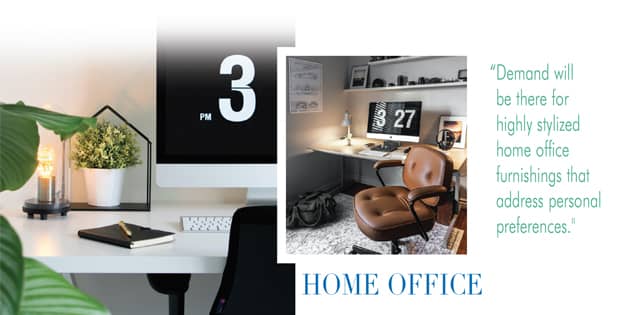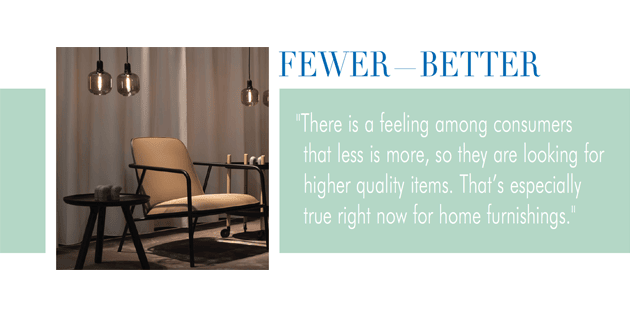
Fashion Snoops' Jaye Anna Mize explains how a shift in consumer values
is likely to affect how and what
they buy for the
fall selling season and into 2021.
The last time Furniture World checked in with Jaye Anna Mize it was business as usual at Fashion Snoops. Zipping around the world, visiting shows, studying consumer behavior, culture and lifestyles are the norm at Fashion Snoops to help manufacturers and retailers create “smarter solutions for their product development needs." We asked her how that has changed.
“We’ve shifted our thinking away from two-year projections," she replied, "and made them a lot more actionable for doing business right now. That’s because our clients need to rethink production and buying issues due to changes in consumer values resulting from the pandemic."
Less Quantity - More Quality
Furniture World began by asking Corey about breaking into interior design.
"Recent events have made consumers a lot more aware of their impact on the world, from an eco-perspective," she explained. "Since people shopped less over the past three months, they had time to clean out, assess their needs and start to redesign. Before that, Americans had been in a nasty cycle of buying really cheap things, then throwing them away without regard. People are redoing their homes right now. We've seen enormous shifts toward outdoor living spaces. The biggest sales are going towards outdoor with the goal of having indoor-outdoor living situations that allow people to stay at home while enjoying nature. Plant sales have soared this season.
"When asked if this trend will continue, Mize noted that "From a wider perspective Fashion Snoops is tracking a shift in consumer values. There’s been a trend away from purchasing cheap clothes and toward loungewear that’s still appropriate for work when you're on a Zoom call. Less quantity and more quality. People had time to declutter their homes—especially during the first two months when they were stuck at home. They needed to make space for working and studying. They had to clean out their closets and get rid of excess stuff they had purchased over the years."
Styled Home Offices
"Most people had to scramble to figure out how to set up home office spaces. Home office sales, obviously, went wild. Going forward, people who don’t need to spend every day at a corporate office will continue to re-shift their work-life balance to create more flexibility, family and discretionary time. Now that people know that they can effectively perform the majority of their work duties at home I believe this trend will continue.
“Demand will be there for highly stylized home office furnishings that address personal preferences." She replied. "For a really long time we were stuck in style categories such as Shabby Chic and Coastal. These were trended molds that people identified with and adhered to. Now consumers want to mix whatever they like.
“Every single retailer should be upping their home office game 100 percent. I’ve done a lot of digging and there aren’t a lot of really amazing desk solutions out there.
“Retailers should be looking for flexible working spaces and sitting/standing desks that don’t clunkily go up and down. Chairs for a home office need to be both comfortable and cute. So there's a lot of opportunity for furniture brands to create home office chairs that are stylish. Similarly, there’s a lot of room for retailers to work on creative displays. Shoppers will be looking for ideas from a visual merchandising perspective with options for home office and learning areas for kids since home schooling is not going away any time soon.
“Instead of just displaying a basic desk and chair, think about creating smart office spaces that include shelving and organizational systems that inspire customers to imagine how this area might be used in their homes."
Safe, Sustainable, Responsible
“We anticipate the recent focus on safety in the home will continue. People will be thinking about and investing in touchless applications such as Delta and Panasonic voice-activated systems, touchless keypads and lighting. Even those consumers who haven’t embraced social distancing and wearing masks in public throughout the pandemic will be more aware how diseases are transmitted. This will fuel an uptick of sales in this area.
“They will be looking for antimicrobial fabrics and home furnishings that are more sustainably focused. They will want to know where the products they purchase are made as well. Was the item they are considering for purchase made for a subsistence wage in a third-world country?"

Emotional Awareness
It’s interesting to see the data on how consumers’ value systems are changing to include more emotional awareness.
“Increasingly, especially younger consumers are on the lookout for inclusivity within the retail stores they frequent. They want to know the stories behind the brands they see in stores. And, they want to feel good about the store itself. Is there ‘enough’ racial equality for them to continue to shop there? Home furnishings companies need a plan for pushing forward with diversity. It's an important part of brand stories that can make younger consumers be comfortable, maybe even passionate about spending their money.
“We have to admit that as an industry, we are pretty well stacked with white males at the top of the food chain. Diversity has become a much more important consideration in the hiring process."

Fewer, Better Things
“People will want fewer, better things which ties in with the sustainability crisis. There is a feeling among consumers that less is more, so they are looking for higher quality items. That’s especially true right now for home furnishings.
They will be more focused on purchasing items that have an emotional pull. These purchases will be personality driven and speak to developing an overall aesthetic. This is exciting in the sense that people are going to buy items that are more valuable to them, have more of a backstory, will last longer and be more sustainable. Consumers will be less inclined to flip accessories out to achieve fresh looks. Instead, they will look to purchase furnishings that are pricier and promise lasting quality."
Other Opportunities
Furniture Word asked if Fashion Snoops sees any unexpected opportunities out there for retailers.
“Yes," she replied. "One of the biggest surprises we saw over the past few months was a big increase in pet adoptions. I know that sounds crazy, but as people went into isolation, pet adoption rates soared. Animal shelters ran out of pets and it seemed like everybody walking around New York City had a new dog to deal with the loneliness. This has created a huge market share opportunity. Devoting additional floor space to pet furniture will be a smart move. Think pet houses that match their owners’ homes, plus cozy pet bed options, toys and accessories.
“Another market we’ve been following at Fashion Snoops that's really taken off is games and gaming—the screen-free variety. Everything from puzzles to board games have really flown off the shelves because people have wanted to digitally detox."
Devoting additional floor space to pet furniture
will be a smart move.
Think pet houses that match their owners’ homes, plus cozy pet
bed options, toys and accessories.
Big Disconnect at Retail
Mize says there will be supply chain difficulties and a disconnect between what consumers want to buy and what retailers will be able to deliver. "There was initially a huge gap in production from China which came back pretty quickly. Some consumers don't want to invest in Chinese products right now. India on the other hand is going through a crisis. That’s a problem for the home furnishings industry since the majority of our textiles are made there. There is going to be a lag in sourcing fabrics for furniture applications.
What we will see going forward is a disconnect between what consumers want to buy and the ability of retailers to source products to meet those needs.
|
"What we will see going forward is a disconnect between what consumers want to buy and the ability of retailers to source products to meet those needs. Over the past three months Fashion Snoops has been working with retailers to help them figure out their assortment priorities. Especially how they should be looking at business for the fall."
Uptick in DIY Items
"Our best guess is that seasonally we're going to be hit hard due to supply chain issues, so we will see a huge uptick in DIY items. People are going to want to do it themselves—to create their own kind of holidays. They will be making more thoughtful purchases versus just giving a bunch of gift cards.
"We’ve had to help retailers create a structure to adapt to this probable reality."
Holiday Buying
“I don't think we'll see as many themes, trends, or redundant products for the holidays this year. And, since shoppers won't have as much family come to visit, retailers probably won't need to go over-the-top in terms of display the way we've seen over the past two seasons. It's going to be more basic. That fits in with what we discussed earlier about the shifts in consumers' mindsets toward a less-is-more mentality."
About Fashion Snoops (FS): FS is a global trend forecasting agency that helps companies harness future trends. Merging research and IT, the company provides a collaborative trend platform for creatives - a one-stop-shop to explore new trends, create and share new concepts.
About Jaye Anna Mize: Jaye is Vice President of Creative - Home Interiors + Design Division for the trend-forecasting agency, Fashion Snoops. With a passion for trend psychology, technology and design, Jaye has branched across fashion into home interiors through her development in trend forecasting over the past 15 years. Working with major brands worldwide, Jaye spends her time covering international events and analyzing key cultural influencers within the home & interior markets to produce macro and micro projections. She is skilled in understanding consumer behavior and how that connects to product and brand development, lifestyle forecasting, and retail strategies.
Furniture World is the oldest, continuously published trade publication in the United States. It is published for the benefit of furniture retail executives. Print circulation of 20,000 is directed primarily to furniture retailers in the US and Canada. In 1970, the magazine established and endowed the Bernice Bienenstock Furniture Library (www.furniturelibrary.com) in High Point, NC, now a public foundation containing more than 5,000 books on furniture and design dating from 1620. For more information contact editor@furninfo.com.